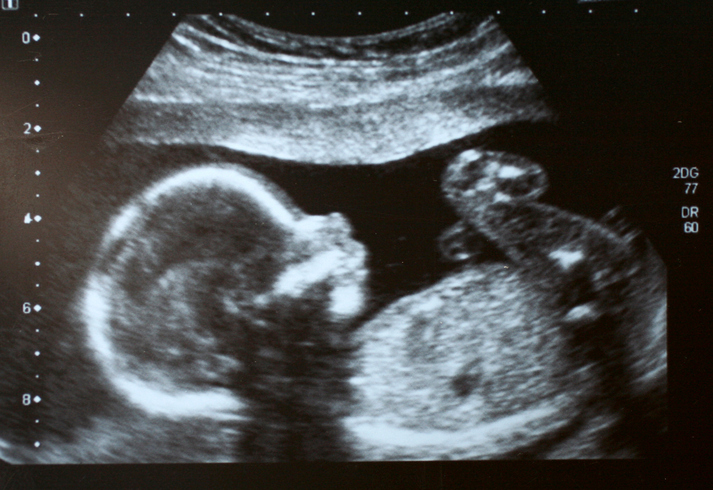Prior to 2016, there was no standardisation of practice regarding the fetal anomaly scan within Northern Ireland.
The content of the anomaly scan anatomy checklist, the process of communicating difficult and unexpected news to parents, and the onward referral process to fetal medicine and fetal cardiology, differed widely between the five Health and Social Care Trusts.
The Fetal Anomaly Scan Improvement Group (FASIG) was set up by the Public Health Agency (PHA) in 2016 to improve the service offered to pregnant women.
The Belfast Trust, being home to paediatric cardiology, appointed a regional lead anomaly scan sonographer to help guide the service. The four peripheral trusts each appointed one lead anomaly scan sonographer, to individually feedback to and support the regional lead.
The work achieved would be impossible without sonographers working within a multi-disciplinary team environment. The group has excellent support professionally, primarily from the PHA who provide the authority for change and guidance regarding the current area of focus.
Additionally, the FASIG has three fetal medicine specialists and three paediatric cardiologists on board, all of whom are immensely supportive. I personally feel like we are a team and not just a disparate group of individuals. We have invaluable expert knowledge that can be genuinely tapped into.
The initial focus has been around the cardiac aspect of the fetal anomaly scan. Paediatric heart surgery ceased in Northern Ireland in 2015. Since then babies with an antenatally detected fetal heart abnormality may have to be transferred for care to Dublin or England depending on the type of cardiac anomaly diagnosed, and the anticipated intervention in early life.
Partly due to the cessation of paediatric heart surgery, it has become of increased importance to improve antenatal detection of congenital heart disease. If a heart abnormality is left undetected and the baby is born with a serious anomaly which requires early intervention, immediate transfer to a specialist unit in Dublin or England can be problematic and inevitably distressing for patients and staff involved.
This first area of improvement around congenital heart disease detection is being achieved slowly but surely. The Fetal Anomaly Screening Programme (England) 2015 guidelines have been adopted, where five cardiac views are obtained during the anomaly scan.
The aim through this change and through developing and following a regional cardiac protocol, is to reach a detection rate of 70% of cardiac anomalies antenatally. We are hopeful that this aspiration is achievable and will monitor progress closely.
To help achieve this target, the Puffin Trust, a charity, delivered hands-on fetal cardiac scanning training days, where experienced sonographers and paediatric cardiologists competent in performing the five FASP cardiac views provided 'hands on' practical teaching. All sonographers were offered the opportunity to undertake this training.
Following this, FASIG invited Tiny Tickers to attend all Trusts and provide hands on training sessions to reinforce the technique previously learnt. Several months following this, two half day 'in touch' information days were delivered, in a neutrally accessible location and over two different dates to maximise attendance. These sessions involved lectures and presentations from the Public Health Agency, paediatric cardiologists and the regional lead sonographer.
This was a good forum to discuss current and best practice, and to address any issues that sonographers had around what was, for some, a significant change of practice. All sonographers are now being offered the chance to spend a day observing fetal medicine and fetal cardiology clinics. This experience is invaluable and will help to improve practice, knowledge and working relationships.
Sonographers throughout the province are now making direct onward referrals to fetal medicine and fetal cardiology. This was not happening in all trusts prior to the formation of the group. Some sonographers felt they would welcome further support to do this. Communicating difficult and unexpected news sessions were therefore offered to all and attendance was facilitated over multiple dates and venues.
A fellow lead and I were involved in steering this training to make sure it was appropriately delivered. Breaking this type of news in the obstetric setting is part of a sonographer’s role and is frequently devastating and immediate. This differs from many other clinical situations where prior preparation can be made.
We have seen through delivering a regional audit process that change is possible and truly invaluable. Audit results are shared and discussed within the group’s meetings. All Trusts re-audit simultaneously to compare performance. Individual sonographer audits are also carried out to ensure protocols are being adhered to, standards are being met and individual sonographer’s training needs are appropriately supported.
Significant change to practice such as this was always going to need careful management and I have learnt much in in the process about how to best implement such a change. I did however have great support from the FASIG members and other sonographers. When I felt overwhelmed by it all, I was reassured and supported. I have also had invaluable support from the Society of Radiographers and from their Ultrasound Advisory Group, of which I am a group member.
Nearly two years on, I am proud of how far we have come. The FASIG is still in its infancy, but has already achieved a great deal since its birth in late 2016. The achievements thus far have been accomplished by the willingness from the staff involved in this service, and the support and guidance from our PHA colleagues.
I am optimistic for the future and excited to see what the FASIG and the sonographers can achieve. Our challenges will alter as technology advances and patient expectation's change.
I have no doubt now that change is good and change we must. To know that we might have made a difference to even just one lady and her unborn baby by detecting a cardiac anomaly that we might not have done so a year ago, makes us feel immensely proud.
The responsibility to help ensure babies are being born in the right place is both onerous and simultaneously professionally satisfying. Today, I love being an obstetric sonographer.
